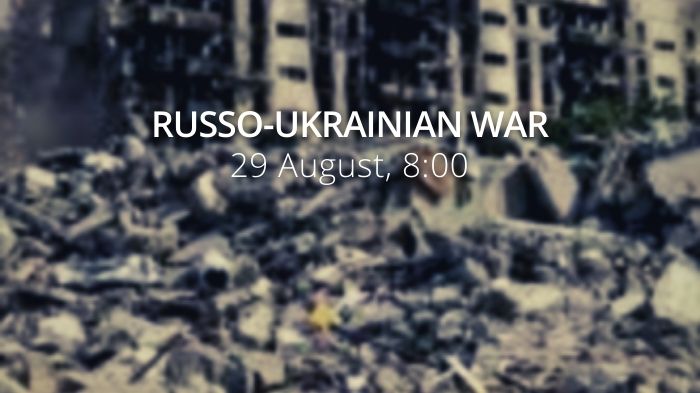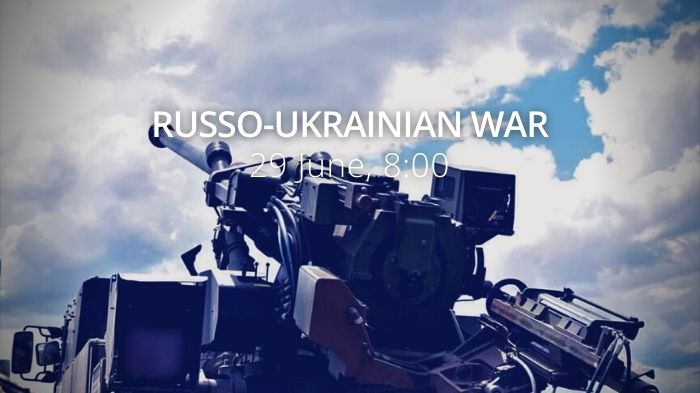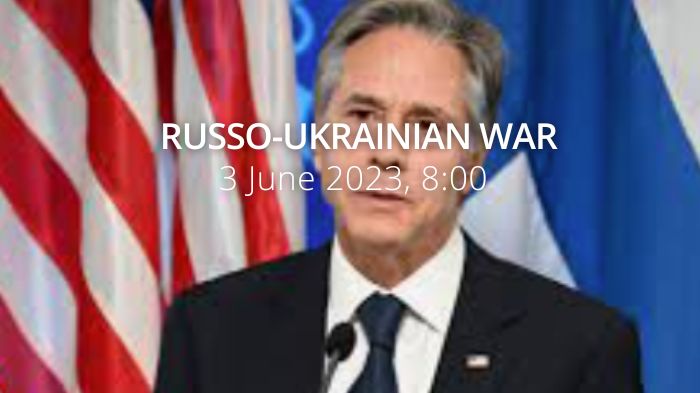Ukrainian army destroys large Russian military base in Melitopol. Night strike in Zaporizhzhia: 9 high-rise buildings and 40 private houses damaged. Russians once again shelled the Mykolaiv Oblast, causing more destruction. More than 500 bodies of fallen defenders already returned to Ukraine. Six more ships leave Ukrainian ports under the grain deal. Russia doesn't acknowledge radiological risk at Ukraine nuclear power plant, the US says. Kazakhstan halts arms exports to Russia.
Daily overview, August 29, 2022
A map of the approximate situation on the ground in Ukraine as of 00:00 UTC 29/08/22.
There have been no notable changes to control since the last update. pic.twitter.com/RqGz3Yt4AM
— War Mapper (@War_Mapper) August 29, 2022
Weekly summary of Russian shelling attacks on August 22-28
Ukrainian military expert Stanislav Haider compiled the official daily stats of the Russian attacks and losses throughout the last week into a weekly summary and compared the figures to the week before. Here’s what he found.
The following statistics show the number of Russian artillery attacks on Ukrainian positions and cities grouped by oblast and by settlement.
The Russian shelling attacks in the last 7 days by oblast:
- Donetsk – 277 attacks (-12 in 7 days as compared to the previous week)
- Kharkiv – 172 attacks (-2 in 7 days)
- Mykolaiv – 78 attacks (+23 in 7 days)
- Zaporizhzhia – 66 attacks (-3 in 7 days)
- Khersonska – 56 attacks (+16 in 7 days)
- Sumy – 20 attacks (-8 in 7 days)
- Chernihiv – 10 attacks (+3 in 7 days)
- Dnipropetrovsk – 5 attacks (+2 in 7 days)
Russian shelling attacks by settlement:
- Vremivka (Donetsk oblast) – 7 attacks
- Olkhivske (Zaporizhzhia oblast) – 7 attacks
- Pavlivka (Donetsk oblast) – 7 attacks
- Soledar (Donetsk oblast) – 7 attacks
- Krasnohorivka (Donetsk oblast) – 7 attacks
- Dolyna (Donetsk oblast) – 7 attacks
- Siversk (Donetsk oblast) – 7 attacks
- Nevelske (Donetsk oblast) – 7 attacks
- Novomykhailivka (Donetsk oblast) – 7 attacks
Average daily Russian losses over the last 7 days
- Troops – 221 fatalities per day (+7 against the previous week);
- Equipment – 24 units per day (-24 with the previous week):
-
- Helicopters – 1 per day (no changes)
- Unmanned aerial vehicles – 5 per day. (+2 against the previous week)
- Tanks – 4 per day (-3)
- Artillery – 3 pieces per day (-3)
- Armored fighting vehicles – 5 per day (-9)
- Transport vehicles – 4 per day (-10)
- MLRS – 1 piece per day (no changes)
- Air defense equipment – 1 unit per day (no changes)
- Over the past 7 days, Ukrainian air defenses have shot down 2 cruise missiles.
Work of Ukrainian artillery
During the past week, the Ukrainian artillery units destroyed the following Russian facilities:
- 27 ammunition warehouses;
- 14 military bases;
- 7 command posts
- 1 military unit.
The General Staff’s operational update regarding the Russian invasion as of 06.00 am, August 26, 2022 is in the dropdown menu below.
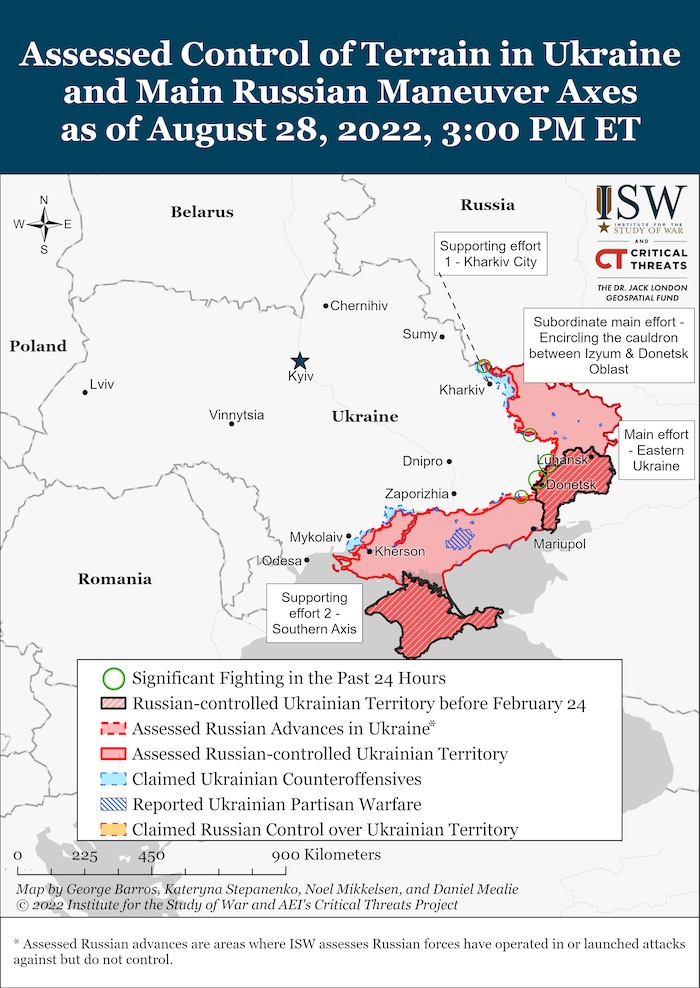
“[Russian forces continues to focus on establishing full control over the territory of Donetsk oblast, the maintenance of captured areas of Kherson, part of Kharkiv, Zaporizhzhia and Mykolaiv oblasts.]
[Air and missile strikes are ongoing on civilian sites in Ukraine.]
[In Volyn and Polissya directions, the situation is without significant changes.]
[In the Siversky direction, Russian forces continue to keep individual units of the Western Military District in the Border districts of the Bryansk and Kursk regions. In order to hinder the actions of the units of defence forces, Russian forces yesterday fired at districts of settlements of Hremyach of Chernihiv oblast and Nova Sloboda, Novovasylivka, Iskrykivshchyna and Turya of Sumy oblast. Conducted air reconnaissance in the border areas of the UAV.] On the last day, Russian forces shelled civilian infrastructure with barrel artillery in the areas of the settlements of Bilopilla, Hai, Katerynivka, Myropilla, and Vodolaga of the Sumy oblast. Conducted aerial reconnaissance with unmanned aerial vehicles.
[In the Slobozhansky direction:]
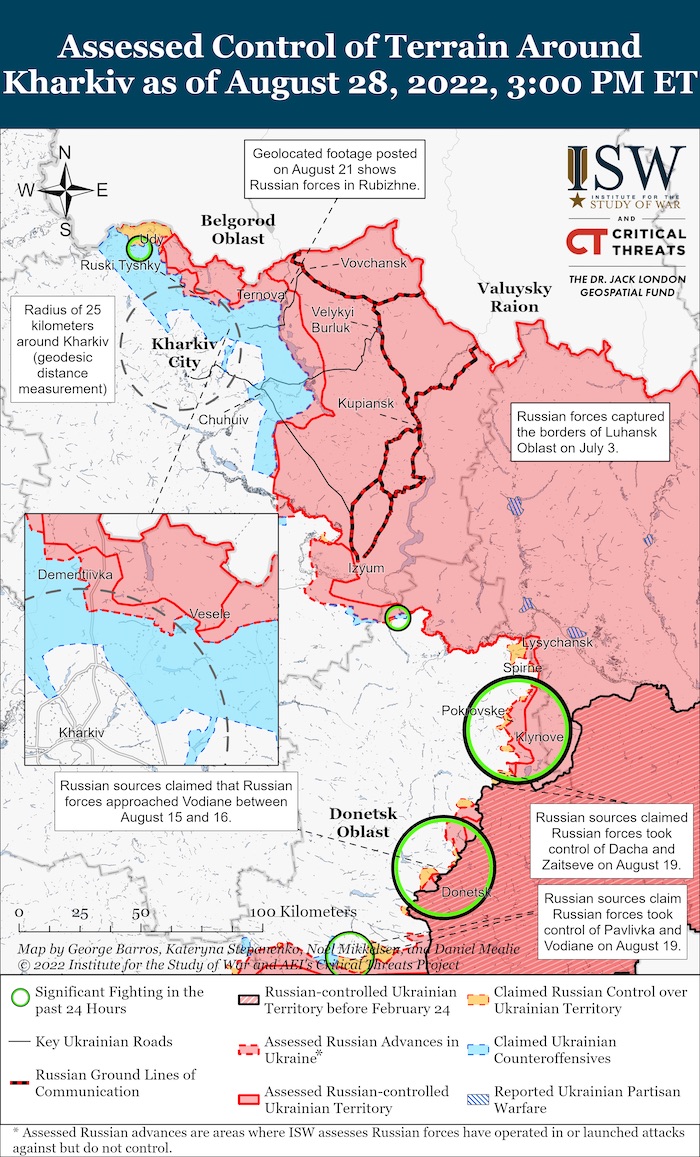
- In the Kharkiv direction, Russian forces shelled territories near Peremoha, Svitlychne, Husarivka, Borshchova, Zalyman, Slatyne, Nove, Ivanivka, Ruska Lozova, and Sosnivka from tanks, combat vehicles, and rocket artillery. Made an airstrike near Nove. Continues intensive aerial reconnaissance of the UAV. [Yesterday, Russian forces fired at tanks, artillery and MLRS in the areas of settlements of Kharkiv, Praudyanka, Protopopivka, Pryshyb, Chepil, Zamulivka, Ruski Tyshky, Bayrak, Petrivka, Mospanove and Velyki Prohody. It launched an airstrike near Rubizhne. Maintains high intensity of UAV intelligence.]
- [It attempted to improve the tactical near Svitlychny, had no success, and withdraw.]
- In the Sloviansk direction, shelling was recorded from tanks, barrel artillery, and MLRS near Kurulka, Brazhkivka, Bohorodychne, Krasnopilla, and Adamivka. Russian forces used reconnaissance UAVs. [Yesteray, the enemy shelling of Dovhenke, Dolyna, Dibrivne, Velyka Komyshuvacha and Karnukhivka were recorded.]
- It tried to carry out a pointless reconnaissance by fighting in the area of the village of Dolyna, suffered losses and withdrew. In order to improve the tactical position, Russian forces carried out assaults near Bohorodychne, without success. [Yesterday, they launched an offensive and assault actions in the Bohorodychne area, suffered losses and withdrew.]
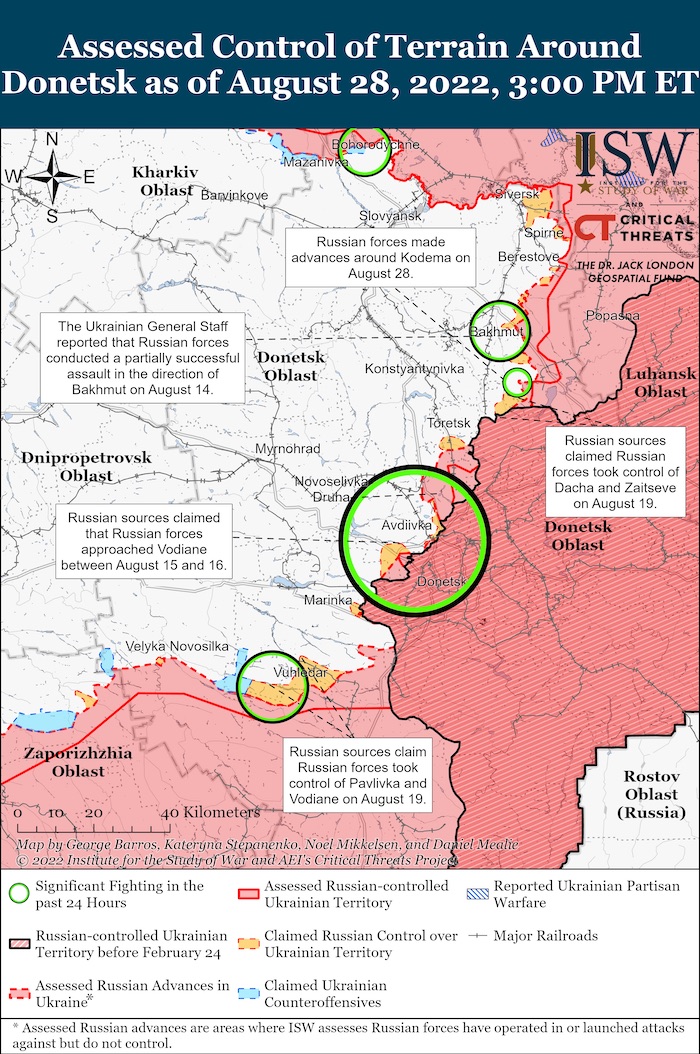
[In the Donetsk direction:]
- In the Kramatorsk direction, shelling from existing artillery systems was recorded near Hryhorivka, Siversk and Ivano-Daryivka. The occupiers also used aviation to strike in the Hryhorivka area. [Yesterday, Russian forces continued the fire influence near Sloviansk, Verkhnyokamyanske and Spirne. It launched airstrikes near Hryhorivka.]
- In the Bakhmut direction, Russian forces shelled military and civilian infrastructure near Bakhmut, Shumy, Yakovlivka, Zaytseve, and Kodema. It carried out airstrikes in the areas of Yakovlivka and Kodema. Continued aerial reconnaissance of the UAV in the specified direction. [Yesterday, Russian forces fired at civilian infrastructure in the areas of Bakhmut settlements, Vesela Dolyna, Soledar, Mayorsk and Rozdolivka. Russia launched airstrikes against Kodema and Yakovlivka districts.[
- Russian force's attempts to conduct offensive battles near Kodema and Zaitsevo were stopped by Ukrainian defenders. [Yesterday, Ukrainian forces repelled the attacks of the invaders near the Vesela Dolyna.]
- In the Avdiivka direction, the areas of Avdiivka, Vodyane, Vesele, Mariinka, Oleksandropil and Tonenke were affected by the fire. [Yesterday, Russian forces fired from the tanks, artillery and MLRS districts of settlements Nevelske, Opytne, Orlovka, Novooleksandrivka, New York, Krasnohorivka and Pervomaiske.]
- In order to improve the tactical position, Russian forces conducted offensive battles in the area of Pervomaiske, without success. [Yesterday, they made an unsuccessful attempt in the area of Pervomaiske, suffered losses and withdrew.]
- In the Novopavlivka direction, the positions of our troops were shelled from tanks, barrel artillery and MLRS near Pavlivka, Volodymyrivka, Konstyantynivka and Novoukrainka. Russian forces used aircraft to strike in the area of [Yesterday, Russian forces continued the shelling near the Vyhledar, Bohoyavlenka, Velyka Novosilka and Novomykhailivka.]
- [Yesterday, they tried to improve the tactical position near Pavlivka, but with no success.]
- In the Zaporizhzhia region, the occupiers shelled positions from artillery, MLRS and tanks in the areas of the settlements of Dorozhnianka, Shevchenko, Poltavka, Bilohirya, and Novopil. Airstrikes were carried out near Novopole and Novosilka. [Yesterday, Russian forces fired from tanks, artillery and MLRS districts of Hulyaypoel, Hulyaypilske, Kamianske, Burlatske, Vremivka and Chervone. He struck airstrikes near Poltavka.]
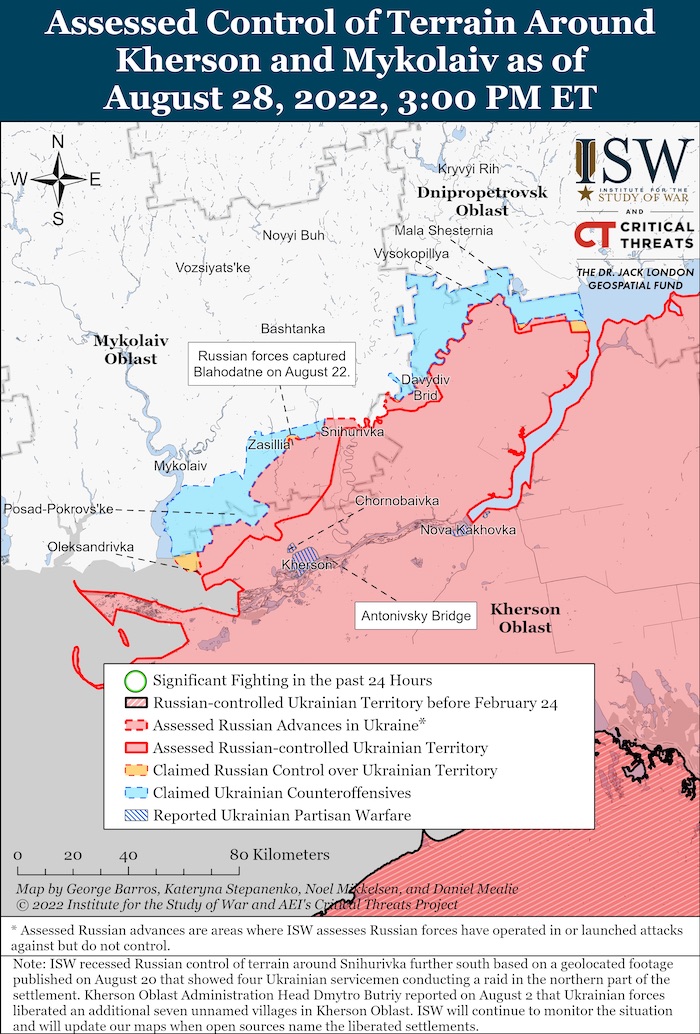
In the Pivdenny Buh direction, Russian forces are concentrating their main efforts on preventing the advance of our troops. Takes measures to replenish losses. The available artillery systems and tanks shelled the infrastructure in the areas of Oleksandrivka, Prybuzke, Novohryhorivka, Pervomaiske, Kvitneve, Kobzartsi, Yakovlivka, Potemkine, Trudolyubivka, Dobryanka, Tavriyske, Shevchenkove, Lyubomyrivka, Bereznehuvate. It used aviation near Novohryhorivka and Andriivka to carry out the strikes. Reconnaissance UAVs of the occupiers were active. [Yesterday, Russian forces carried out shelling with all weapons against settlements of Mykolaiv, Lupartevo, Stepova Dolyna, Posad-Pokrovske, Shyroke, Partyzanske, Kyselivka, Velyke Artakove, Andriyivka, Olhyne, Knyazivka, Topolyne, Myrne, Kvitneve, Veselyi Kut, Lozove. Airstrikes were launched against the area near Andriyivka and Oleksandrivka. The enemy has established an active reconnaissance with UAVs.]
In the Black Sea and the Sea of Azov, a Russian naval group focuses its main efforts on conducting reconnaissance and blocking civilian shipping in the northwestern part of the Black Sea.
Ukrainian soldiers are firmly on the defensive and are ready for any changes in the operational situation. The destruction of enemy command posts of various levels and ammunition depots continues. [Our missile and artillery units continue the fire damage to the clusters of personnel and military equipment of Russian invaders. In some directions, Russian forces have significant losses.]”
Military Updates
Shelling near Ukraine nuclear plant fuels disaster fears; Russia pounds Donbas, Reuters reports. “Russian forces have pounded Ukrainian towns across the river from the Zaporizhzhia nuclear power plant, officials said, while reports of shelling around the facility fuelled fears of a radiation disaster.”
https://twitter.com/EuromaidanPress/status/1564126952574820362
Armed Forces of Ukraine destroy large Russian military base in Melitopol, Ukrainska Pravda reports, citing Ivan Fedorov. “The Armed Forces of Ukraine struck one of the largest Russian military bases on the territory of the Avtokoliorlyt plant [company producing non-ferrous metal for vehicles, tractors and agricultural machinery - ed.] in Melitopol, said the mayor Ivan Fedorov of Melitopol.
In the city of Melitopol, one of the largest enemy military bases on the territory of the Avtokoliorlyt plant has been destroyed."
Ukrainian troops destroy enemy headquarters in Nova Kakhovka, Ukrinform reports, citing Serhiy Khlan, a member of the Kherson Regional Council. "Although the propagandists write that their ‘air defense system’ was clearly heard, the Armed Forces of Ukraine struck ruscists in Nova Kakhovka. He noted that the Ukrainian military hit the headquarters that Russian forces had set up at the Sokil plant.
As reported, the Armed Forces of Ukraine struck the clusters of enemy manpower and equipment in Nova Kakhovka, Liubymivka, and Kherson in Kherson region Sunday night.”
Russia launched a missile attack on the "object of military infrastructure" in Rivne Oblast, Oblast head informed
According to preliminary information, there are no casualties. Missiles were launched from the territory of Belarus. https://t.co/Sxcrgn6FBV pic.twitter.com/FgOH3EBRUm
— Euromaidan Press (@EuromaidanPress) August 28, 2022
According to British Defence Intelligence, (last 48 hours):
- Recent independent Russian media reports have claimed that due to the problems Russia is facing in its war against Ukraine, Russian Defence Minister Sergei Shoigu is now being side-lined within the Russian leadership, with operational commanders briefing President Putin directly on the course of the war.
- Russian officers and soldiers with first-hand experience of the war probably routinely ridicule Shoigu for his ineffectual and out-of-touch leadership as Russian progress has stalled. Shoigu has likely long struggled to overcome his reputation as lacking substantive military experience, as he spent most of his career in the construction sector and the Ministry of Emergency Situations.
- On 25 August 2022, the Russian Presidential Administration issued a presidential decree increasing the established strength of the Russian armed forces to 1,150,628, an increase of nearly 140,000. The government was instructed to provide funding to achieve this.
- It remains unclear whether Russia will attempt to fill this increased allocation from recruiting more volunteer ‘contract’ soldiers, or from increasing the annual targets for the conscription draft. In any case, under the legislation currently in place, the decree is unlikely to make substantive progress towards increasing Russia’s combat power in Ukraine. This is because Russia has lost tens of thousands of troops; very few new contract servicemen are being recruited; and conscripts are technically not obliged to serve outside of Russian territory.
Losses of the Russian army
As of Monday 29 August, the approximate losses of weapons and military equipment of the Russian Armed Forces from the beginning of the war to the present day:
- Personnel – more than 47100 (+350),
- Tanks – 1947 (+5),
- Armoured combat vehicles – 4269 (+12),
- Artillery systems – 1060 (+10),
- Multiple rocket launchers –MLRS - 279 (+5),
- Air defence means – 149 (+1),
- Aircraft - 234 (+0),
- Helicopters - 203 (+1),
- Automotive technology and fuel tanks – 3188 (+17),
- Vessels/boats - 15 (+0),
- UAV operational and tactical level – 838 (+2),
- Special equipment – 101 (+2),
- Mobile SRBM system – 4 (+0),
- Cruise missiles – - 196 (+0)
Russian enemy suffered the greatest losses (of the last day) in the Donetsk direction.
Forbes: Ukraine has destroyed Russian military equipment worth $16.6 billion since Feb. 24, Kyiv Post reported on 24 August. “In six months of Russia's war in Ukraine, Russia has lost 12,142 pieces of equipment worth $16.56 billion, excluding missiles, according to Forbes. The most significant loss of the Russian army was the sinking of the Moskva missile cruiser on April 14, worth $750 million.”
Day of remembrance – statement by the Commander in Chief of the Ukrainian Armed Forces. “Today is the Day of Remembrance of defenders of Ukraine who died in the struggle for independence, sovereignty, and territorial integrity of Ukraine. Every day we should remember the price our people paid and continue to pay for their freedom.
There are no right words or right moments when it comes to losses. Because these are the broken destinies of special people who were the whole universe for their relatives. Unfortunately, heroes die. They gain eternal life and eternal glory and remain our spiritual guide and an example for future generations of Ukrainians. But they are no more for those who need them alive.
I bow my head and share with my relatives and friends the pain of irreparable loss. Thank you for the greatest sacrifice, consciously given to your country. This is how history is made and a nation is formed that will be admired by the world. I promise, that no sacrifice will be in vain - we will continue the fight until our Victory. General Valerii Zaluzhnyi.”
Kazakhstan halts arms exports, Ukrainska Pravda reports, citing the website of the Prime Minister of Kazakhstan. "Participants (of the Defence Industry Commission meeting - UP) considered the proposal of the Ministry of Industry and Infrastructural Development to suspend the export of weapons, military equipment and products intended for military use until the end of August 2023. This proposal was supported by the members of the Commission."
On 22 February, Kazakhstan did not recognise the Russian-occupied parts of Donbas as independent, citing international law. The country also rejected the dispatch of Collective Security Treaty Organisation troops to Ukraine, which is known as "the Russian NATO". Kazakhstan also rejected the Russian Federation's request to send its troops to join their assault against Ukraine.”
⚰️russia's combat losses in Ukraine as of August 29
▪ 47100 killed soldiers (+350)
▪ 4259 APV (+12)
▪ 1947 tanks (+5)
▪ 1060 artillery systems (+10)
▪ 234 aircraft and 203 helicopters (+1)
▪ 15 boats and cutters#StopRussia #StandWithUkraine pic.twitter.com/vIVZguf4ru— VoxUkraine (@voxukraine) August 29, 2022
Humanitarian
#Russia teaches #Mariupol children to shoot and to hate #Ukraine #Zaporizhzhia #Kherson #Luhansk #StandWithUkraine #RussiaWarCrimes #StopRussia https://t.co/iUWyUY0yHc pic.twitter.com/iwoJbffghG
— Halya Coynash (@halyapuff) August 29, 2022
Ukraine is likely to face the coldest winter in decades, Ukrinform reports, citing The Guardian. “According to Yuriy Vitrenko, Naftogaz Board Chairman, “Ukrainians are likely to experience the coldest winter in decades, as indoor temperatures will be set at between 17-18 degrees Celsius, which is about four degrees lower than normal. According to Vitrenko, the heating season will start later and end sooner.
The situation will depend on Ukraine’s international allies granting funds to purchase 4 billion cubic meters of natural gas, as well as different unpredictable factors, such as Russia destroying gas infrastructure or further decreasing its gas supplies to Europe. Without the [western] financial support we will lack gas and it will mean we’ll have really high risks for the power system [going] down. […] [Without the gas imports], there will be blackouts in big parts of Ukraine.
Ukraine needs to import about 10 billion cubic meters of natural gas. According to Vitrenko, in his opinion, Ukraine’s allies understand the need, but he cannot be confident Ukraine will get the funds […]. However, the current calculus may change if, for example, Russia decides to target any critical gas infrastructure facility, power plants or gas production enterprises in Ukraine. About 50% of Ukraine’s gas fields are located in Kharkiv Region, just 6-7 kilometres away from the front line. If they or Ukrainian gas storage facilities are damaged, Ukraine will need to import more gas.
Russia may also decide to further decrease its gas supplies to the EU, making the cost of gas even more expensive. Earlier this year, Russia already cut gas supplies to Europe, which dramatically increased gas and electricity prices in some countries, including the United Kingdom.”
For the past six months, photographers with news organizations throughout Ukraine have chronicled the ordeal of Russo-Ukrainian war. These are some photos from August 2022, published by NYT. Read the descriptions in ALT. More photos https://t.co/xk9hlPZNZL pic.twitter.com/UKM3ZbhtXX
— Euromaidan Press (@EuromaidanPress) August 28, 2022
Night strike in Zaporizhzhia: 9 high-rise buildings and 40 private houses damaged, Ukrainska Pravda reports, citing Anatolii Kurtiev, Acting Mayor of Zaporizhzhia. "9 multi-storey and dozens of private houses were damaged during a night strike of Russian occupation forces in Zaporizhzhia. In apartment buildings, the blast wave shattered windows and destroyed window frames in apartments and stairwells. 40 private houses were also damaged. Unfortunately, two of them are completely destroyed."
Russians once again shelled Mykolaiv region, causing more destruction, Ukrinform reports, citing the press service of the Ministry of Internal Affairs. “Residential buildings and agricultural premises were destroyed in Shyroke. Into all these facts, criminal proceedings have been initiated under Part 1 of Art. 438 of the Criminal Code of Ukraine ‘violation of the laws and customs of war,’ the statement says. As reported earlier, more than 9,800 civilian objects have been damaged in Mykolayiv region since war-start.”
More than 500 bodies of fallen defenders already returned to Ukraine, Ukrinform reports, citing Commissioner on Persons Gone Missing, Oleh Kotenko. “According to Kotenko, the Ukrainian Temporarily Occupied Territories Reintegration Ministry is continuously working to bring back the bodies of Ukrainian servicemen. With the establishment of the Commissioner’s Office in late May 2022, this process accelerated.
Through the International Committee of the Red Cross (ICRC), communication with the Russian side has been established. Holding talks with the aggressor is difficult, but we have already managed to bring back 541 bodies of the fallen defenders. A total of 428 bodies were transported from Mariupol, and over 300 of them are those of the Azovstal defenders. We are bringing back the bodies of the fallen from such directions as Donetsk, Zaporizhzhia, Kherson, Kharkiv, Luhansk, from everywhere,” Kotenko told.”
Six more ships leave Ukrainian ports under grain deal, Ukrinform reports, citing Türkiye's Ministry of Defense
. “Six vessels carrying Ukrainian agricultural products left Ukraine's Black Sea ports early on August 28 under an UN-brokered grain deal. In total, 51 ships with Ukrainian agricultural products have left the Black Sea ports of the Odesa region since the sea blockade was lifted on August 1.”
“The route to life.” How volunteers secretly rescued 75,000 from a city encircled by Russian troops
️️Environmental

If an accident were to occur at Zaporizhzhia Nuclear Power Plant right now, radiation would cover part of Russia, Ukrainska Pravda reports, citing Energoatom. “In the event of a severe accident at the Zaporizhzhia NPP, the radiation cloud – according to the wind forecast on Monday 29 August – would cover part of the south of Ukraine and the southwestern regions of the Russian Federation.
The population in potentially dangerous areas is advised to carry out iodine prophylaxis and limit their stay in open areas when there is not an urgent need, and in case of the appearance of a radioactive cloud, to use protective means for respiratory organs.
IAEA says no increase in radiation levels at Zaporizhzhia NPP, Ukrinform reports, citing a statement on the situation in Ukraine, published on the IAEA's official website. “IAEA Director General Rafael Mariano Grossi spoke [Sunday] about the current radiation situation at the Zaporizhzhia Nuclear Power Plant (ZNPP), which Russian forces have occupied since the beginning of March.
"Ukraine has informed the International Atomic Energy Agency (IAEA) of renewed shelling in recent days at the site of the country’s Zaporizhzhia Nuclear Power Plant (ZNPP), but it said all safety systems remained operational and there had been no increase in radiation levels, Director General Rafael Mariano Grossi said today, the statement said.”
Russia doesn't acknowledge radiological risk at Ukraine nuclear power plant, the US says, Reuters reports. “The United States said on Sunday that Russia did not want to acknowledge the grave radiological risk at the Zaporizhzhia Nuclear Power Plant in Ukraine, adding that was the reason it blocked a nuclear non-proliferation treaty deal's final draft.
The Russian Federation alone decided to block consensus on a final document at the conclusion of the Tenth Review Conference of the Nuclear Non-Proliferation Treaty (NPT). Russia did so in order to block language that merely acknowledged the grave radiological risk at the Zaporizhzhia Nuclear Power Plant in Ukraine, the US State Department said in a statement.”
US State Department statement: “We are proud to have worked constructively and in good faith with all Parties toward a consensus. Russia’s actions reflect only on Russia. It is clear that the rest of the NPT’s States Parties recognize the Treaty’s role as an essential pillar of the international rules-based order.”
Legal
In Zaporizhzhia region, invaders planning to hold poll instead of 'referendum', Ukrinform reports, citing Melitopol Mayor Ivan Fedorov. "The occupiers do not want to hold a pseudo-referendum on September 11, but they want to hold it as part of a survey from September 11 to 17 and then draw conclusions. Residents of other cities and even countries will be able to participate in this pseudo-referendum. In Russia, they want to open such precincts in order to rig the vote and declare that 110% supports the Russian Federation, the mayor said.”
Invaders plan to hold pseudo-referendum in captured areas of Kharkiv region in October, Ukrinform reports. “In the temporarily captured territory of Kharkiv region, the Russian invaders plan to organize a pseudo-referendum in October and invite people to sign a petition for its holding.
In particular, the United Russia party member Yevgeny Yevtushenko started collecting signatures for the petition "for holding a general referendum" in the town of Vovchansk and nearby villages. People are informed that they will have two options to choose from: "joining the Russian Federation" or "getting autonomous independence of the liberated territories."
As reported, according to the Chief Directorate of Intelligence of the Ministry of Defense of Ukraine, Russia's preparations for holding pseudo-referendums in the temporarily captured territories of Zaporizhzhia and Kherson regions are almost complete.»
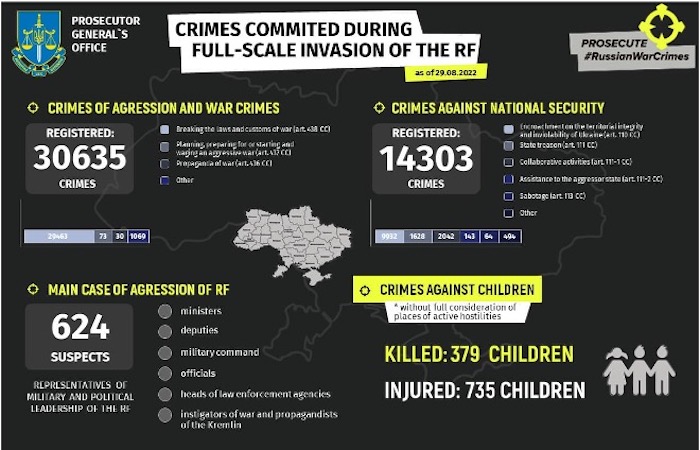
379 children were killed, 735 children injured, 7,013 deported by foe forces, and 223 reported missing - the Office of the Prosecutor General of Ukraine reports as of August 29. 2,328 educational establishments are damaged as a result of shelling and bombings, 289 of them are destroyed fully. 30,635 crimes of aggression and war crimes and 14,303 crimes against national security were registered.
Support
Not all of the $54 bn that US provided in assistance bills to Ukraine during 2022 is actually for Ukraine – a substantial amount is directed outside the country
We analyzed a lot of numbers & figured out how much of US aid actually goes to Ukraine https://t.co/EN9LhlDchW
— Euromaidan Press (@EuromaidanPress) August 28, 2022
Berlin to support Ukraine financially and militarily as long as it takes, Ukrinform reports. “German Foreign Minister Annalena Baerbock pledged long-term support in the war against Russia to Ukraine if necessary. According to her, Ukraine also protects the freedom and peaceful order of Europe, so Berlin supports Kyiv financially and militarily as long as it takes, Bild reports. Baerbock noted that the war could last for years.
Of course, I would like the war to end as soon as possible, but, unfortunately, we have to assume that Ukraine will still need new heavy weapons from its friends next summer," said the German foreign minister. She warned against talks of war fatigue in Germany given the months of fighting and noted that the world would have to adjust to the fact that this war could last for years.
Of course, everyone now feels the consequences of Putin's energy war with their wallets. The social division of Europe is part of Putin's war. We must prevent this, the diplomat said.
She added that there was a difficult road ahead, noting that part of the political responsibility of the authorities was to mitigate the social imbalance caused by high energy prices. At the same time, the politician categorically rejected the calls of Bundestag Vice President Wolfgang Kubicki to use the Nord Stream 2 gas pipeline because Russian gas pipelines had long since turned into a weapon in a hybrid war.
Baerbock emphasized that the Russian government would not abandon its intention to subjugate Ukraine and its people, but Putin's plans must not become reality. At the same time, the minister clearly called Crimea a Ukrainian territory.”
Co-leader of German Green Party and Minister of Foreign Affairs Annalena Baerbock says it is "madness" to postpone abandonment of the last nuclear power plants in Germany, despite extremely high prices and risk of complete stoppage of Russian gas supplies https://t.co/BfrmWozZQU
— Euromaidan Press (@EuromaidanPress) August 28, 2022
The UK donating undersea minehunter drones to help Ukraine clear its coastline, according to a press release from the UK Government. “The UK is giving underwater drones to Ukraine and training Ukrainian personnel in Britain to use them to clear their coastline of mines. Six autonomous minehunting vehicles will be sent to the country to help detect Russian mines in the waters off its coast. Three of these will be provided from UK stocks, with a further three to be purchased from industry.
The lightweight autonomous vehicle is designed for use in shallow coastal environments, operating effectively at depths of up to 100m to detect, locate and identify mines using an array of sensors so the Ukrainian Navy can destroy them. Dozens of Ukrainian Navy personnel will be taught to use the drones over the coming months, with the first tranche having already begun their training.”
New Developments
- Ukraine will retake all temporarily occupied territories – Zelensky, Ukrinform “Ukraine will regain control of all temporarily occupied territories, and Russian terrorism will not go unanswered. Ukrainian President Volodymyr Zelensky said this in his latest video address.”
- Parties to NPT condemn Russia’s aggression in Ukraine, Ukrinform reports, citing the statement by the parties to the NPT. “The parties to the Treaty on the Non-Proliferation of Nuclear Weapons (NPT) strongly condemned the unprovoked and unjustified war of aggression of the Russian Federation against Ukraine and called on the occupiers to withdraw their troops from Ukraine.”
- Ukraine's victory should be such as to permanently prevent Russia's attempts to encroach on foreign territories, the National Security and Defence Council of Ukraine states. “Ukraine's victory must be such as to make it forever impossible for the Russian Federation to encroach on foreign territories. Secretary of the National Security and Defense Council of Ukraine Oleksiy Danilov said. The entire territory of our country, including the Crimea, Donetsk, and Luhansk regions, will be liberated from the aggressor. At the same time, the NSDC Secretary noted […] we need to be patient, it will not be easy. For us, only the withdrawal of Russian troops from all temporarily occupied territories of Ukraine is acceptable", - the NSDC Secretary noticed adding that all other proposals are only postponing the solution of the problem, and Ukrainian society will not accept it.”
"The missile smashes into the ground 10m from me, creating a vacuum & sucking the air towards it, like a giant magnet mercilessly pulling everything in its vicinity"
Ivan survived when Russia struck the military barracks in Yavoriv. His comrades did not. https://t.co/MVfcvz9VjE
— Euromaidan Press (@EuromaidanPress) August 28, 2022
Assessment
- On the war.
Map https://www.understandingwar.org/backgrounder/russian-offensive-campaign-assessment-august-20*
The Institute for the Study of War has made the following assessment as of Sunday 28 August:
- On the War
“Russian President Vladimir Putin signed two decrees on August 27 in a reported effort to assist stateless peoples and residents of Donbas and Ukraine live and work in the Russian Federation. The first decree allows Donbas residents, Ukrainians, and stateless peoples to live and work in Russia indefinitely. The decree also allows Ukrainian and Donbas residents to work in Russia without a permit so long as they have acquired an identification card within 30 days of the August 27 decree. The order also requires that all Donbas and Ukrainian residents arriving to Russia undergo mandatory fingerprint registration and a medical examination for the use of drugs, psychotropic substances, infectious diseases, and HIV.
The second decree orders Russian social services to provide social payments to individuals forced to leave Ukraine and the self-proclaimed Donetsk and Luhansk People’s Republic (DNR and LNR) for Russia after February 18, 2022. The decree mandates that social services provide monthly pension payments of 10,000 rubles (approximately $167) to all affected peoples, pension payments of 3,000 rubles (approximately $50) to those with disabilities or those over the age of 80, and payments of 5,000 rubles (approximately $83) to World War II veterans. The decree also orders that social services pay pregnant women 10,000 rubles during pregnancy and an additional 20,000 rubles (approximately $332) when the child is born. The decree excludes refugees and specifies that Russian Federal Republics must execute the payments to the parties.
Russian and Ukrainian forces continued to trade claims of shelling at the Zaporizhzhia Nuclear Power Plant, including at the Tenth Review Conference of the Treaty on the Non-Proliferation of Nuclear Weapons. Russia blocked a proposal aimed at strengthening the Treaty on the Non-Proliferation of Nuclear Weapons on August 27 in objection to a clause concerning Ukrainian control of the Zaporizhzhia Nuclear Power Plant. The Ukrainian Mission to the United Nations published a statement signed by a large proportion of NPT signatories at the last meeting of the conference that condemned Russian aggression in Ukraine, nuclear rhetoric, and provocative statements as “inconsistent with the recent P5 Leaders Joint Statement on Preventing Nuclear War and Avoiding Arms Races.”
Russia has further begun to implement strategies similar to those used by Iran in attempt to manipulate and possibly delay an International Atomic Energy Agency (IAEA) mission to the plant in the near future. The New York Times reported on August 27 that the IAEA had assembled a mission consisting of IAEA Chief Rafael Mariano Grossi and 13 experts from “mostly neutral countries” to visit Zaporizhzhia Nuclear Power Plant for observation next week. The list notably excludes the United States and the United Kingdom, which Russia views as unfairly biased. The IAEA stated that the IAEA remained in active consultations for an upcoming mission. Ukrainian official sources have reported that Russian special forces are torturing Zaporizhzhia Nuclear Power Plant employees to prevent them from disclosing safety violations to IAEA inspectors, that Russian authorities are attempting to limit the presence of Ukrainian employees at the plant, and that occupation authorities have begun collecting signatures from Enerhodar residents demanding an end to Ukrainian shelling to present to inspectors. Manipulation of the nationality of inspectors and attacks on the “fairness” of IAEA inspections are tactics that Iran has long used to obfuscate its obstruction of IAEA inspections.
Key Takeaways
- Russian President Vladimir Putin issued two decrees in a reported effort to assist stateless peoples and residents of Donbas and Ukraine live and work in the Russian Federation.
- Russian forces conducted unsuccessful offensive operations northwest of Sloviansk.
- Russian forces conducted limited ground attacks southeast of Bakhmut and west and southwest of Donetsk City.
- Russian forces conducted a limited ground attack north of Kharkiv City.
- Russian forces did not conduct any reported offensive operations in Kherson or Zaporizhzhia Oblasts.
- The Kremlin likely directed a media outlet closely affiliated with Moscow to criticize the Governor of St. Petersburg Alexander Beglov for failing to incentivize recruitment to volunteer battalions within the city.
Russian occupation authorities continued efforts to facilitate the integration of the education system in occupied territories in Ukraine according to Russian standards.“
- Consequences and what to do?
Senator Warren worries that Fed will tip the US economy into recession, Reuters reports. “Democratic US Senator Elizabeth Warren said on Sunday that she was very worried that the Federal Reserve was going to tip the nation's economy into recession and that interest rate hikes would put people out of work.
The US central bank's chief, Jerome Powell, warned on Friday that Americans were headed for a painful period of slow economic growth and possibly rising joblessness as the Federal Reserve raises interest rates to fight high inflation. Powell said in a speech on Friday the Fed will raise rates as high as needed, and would keep them there "for some time" to bring down inflation that is running at more than three times the Fed's 2% goal. […]
Warren said inflation was high partly due to supply chain problems, the COVID-19 pandemic and the war between Russia and Ukraine.”
In Poland, where coal is king, homeowners queue for days to buy fuel, Reuters reports. “In Poland's late summer heat, dozens of cars and trucks line up at the Lubelski Wegiel Bogdanka coal mine, as householders fearful of winter shortages wait for days and nights to stock up on heating fuel in queues reminiscent of communist times. […] Toilets were put up today, but there's no running water, he said, after three nights of sleeping in his small red hatchback in a crawling queue of trucks, tractors towing trailers and private cars.
This is beyond imagination, people are sleeping in their cars. I remember the communist times but it didn't cross my mind that we could return to something even worse.
Artur's household is one of the 3.8 million in Poland that rely on coal for heating and now face shortages and price hikes, after Poland and the European Union imposed an embargo on Russian coal following Moscow's invasion of Ukraine in February.”
Hans Petter Midttun: During the last years I have consistently argued that NATO needs to deploy military forces to Ukraine. Since February 24, I have advocated for humanitarian intervention and stressed the need to close the sky and break the maritime embargo. I have not least, argued strongly in favour of providing Ukraine with the weapons it needs to defeat and evict Russian forces from Ukraine.
The primary argument in favour of this should have been based on a moral stand. Both NATO and the EU have established a set of values and principles that supports the direct intervention. It is the right thing to do. International diplomacy, however, does not consider moral issues. The actions of the West are first of all governed by the national interests of each individual country.
Recognising the nature of international diplomacy, I have argued for humanitarian intervention in Ukraine for primarily four reasons, all of which are directly linked to our national interests.
Firstly, humanitarian intervention would have been in line with NATO’s strategic concepts from 1999-2022. According to the previous concepts, NATO was meant to “help manage developing crises that have the potential to affect Alliance security, before they escalate into conflicts; to stop ongoing conflicts where they affect Alliance security.” Unfortunately, in NATO’s new Strategic Concept 2022 the very strong statements of the past were deleted and the Alliance committed to doing less.
Secondly, I argued that the consequences of a potential Russian victory would be devastating for European security and stability. It will not only embolden and strengthen Russia but also create lasting instability along our common borders. I stressed that a resolute response and extreme measures were needed to stop the Hybrid War. I argued that if the EU/NATO find the consequences “acceptable” and in line with the national interest of the individual nations, there was no need to adapt their present strategy. If unacceptable, however, the West needs to adjust its strategy to the realities of the Hybrid War.
Thirdly, I have argued that the “tsunami of ripple effects” from the war will have a global impact. The ripple effects include increased costs of living, food and energy insecurity, famine, recession, inflation, and more, increasing the likelihood of global unrest, riots, and collapse of the governments. I have argued that the political landscape in both the USA and Europe might change in the time to come as voters grow increasingly frustrated.
Lastly, I have argued I have long argued that Western humanitarian intervention is inevitable since the West is running out of weapons it can supply Ukraine which it can use with no or limited training. The options left for us are either to see Ukraine fail or to provide it with both the weapons and the personnel needed to operate them efficiently. The former is, fortunately, no option. In the same manner, as logistics forced Russia to adjust its initial operational objectives for the invasion, logistics are about to force the Alliance to change its strategy.
All five arguments – including the one based on “it’s the right thing to do” - are still valid. The relevance of the last two, however, is increasing daily. Media reports from both the USA and Europe clearly underline the global costs of war. These costs will only increase in the months to come.
Our Heads of State are left with two options: Either accept the costs and accept being voted out of office during the next election, or end the war. The latter is fully within their reach once they accept the need to counter the Russian nuclear “fait accompli” strategy.
Since neither Ukraine nor Russia usually reports the cause of explosions on Russian-occupied territory, it should be Bavovnyatko, a ghost animal that plays with fire. Bavovnyatko was created by the artist Svitlana Olsevska pic.twitter.com/fKjcFPiB8Q
— Euromaidan Press (@EuromaidanPress) August 29, 2022

